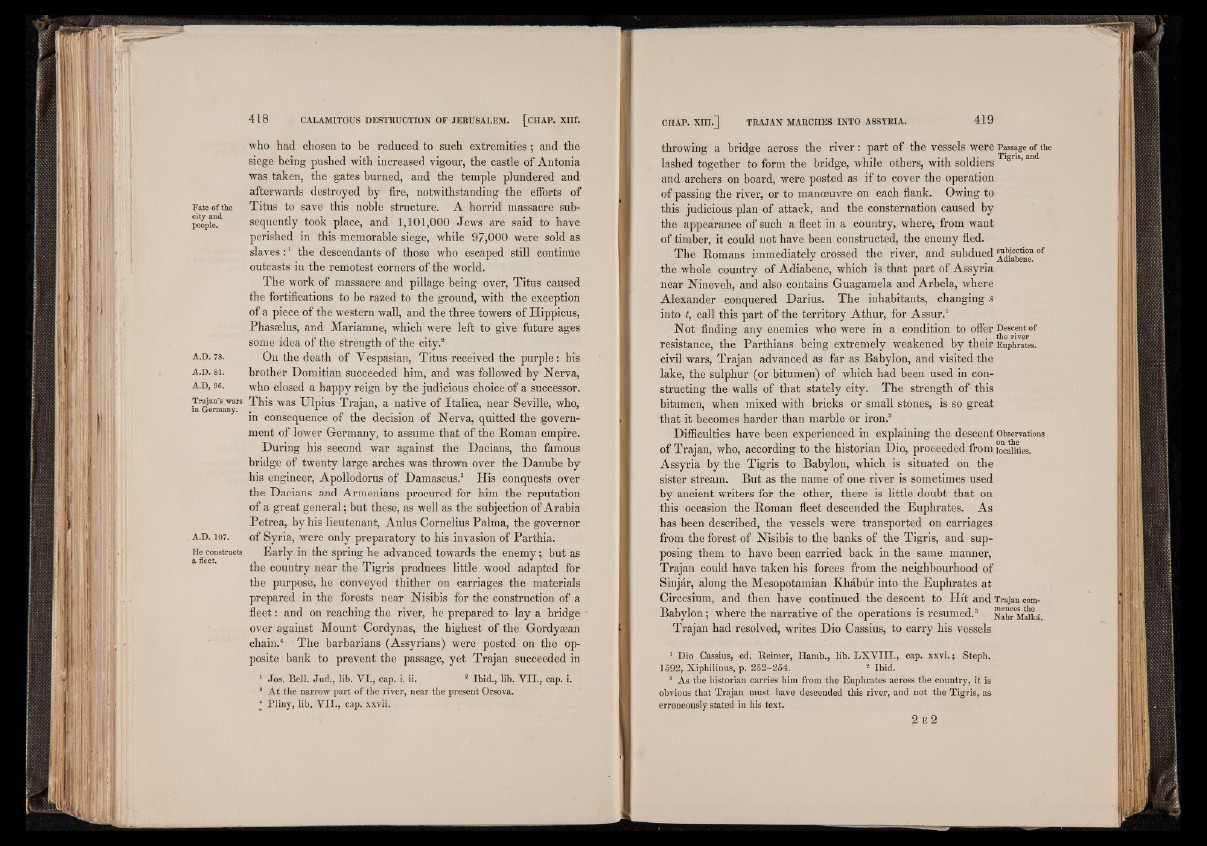
f i
ijlll'
I l i
Fate of the
city and
people.
A.D. 78.
A.D. 81.
A.D, 96.
Trajan's wars
in Germany.
A.D. 107.
He constructs
a fleet.
who had chosen to be reduced to such extremities; and the
siege being pushed with increased vigour, the castle of Antonia
was taken, the gates burned, and the temple plundered and
afterwards destroyed by fire, notwithstanding the efforts of
Titus to save this noble structure. A horrid massacre subsequently
took place, and 1,101,000 Jews are said to have
perished in this memorable siege, while 97,000 were sold as
slaves:1 the descendants of those who escaped still continue
outcasts in the remotest corners of the world.
The work of massacre and pillage being over, Titus caused
the fortifications to be razed to the ground, with the exception
of a piece of the western wall, and the three towers of Hippicus,
Phasselus, and Mariamne, which were left to give future ages
some idea of the Strength of the city.2
On the death of Yespasian, Titus received the purple: his
brother Domitian succeeded him, and was followed by Nerva,
who closed a happy reign by the judicious choice of a successor.
This was Ulpius Trajan, a native of Italica, near Seville, who,
in consequence of the decision of Nerva, quitted the government
of lower Germany, to assume that of the Roman empire.
During his second war against the Dacians, the famous
bridge of twenty large arches was thrown over the Danube by
his engineer, Apollodorus of Damascus.3 His conquests over
the Dacians and Armenians procured for him the reputation
of a great general; but these, as well as the subjection of Arabia
Petrea, by his lieutenant, Aul us Cornelius Palma, the governor
of Syria, were only preparatory to his invasion of Parthia.
Early in the spring he advanced towards the enemy; but as
the country near the Tigris produces little wood adapted for
the purpose, he conveyed thither on carriages the materials
prepared in the forests near Nisibis for the construction of a
fleet: and on reaching the river, he prepared to lay a bridge
over against Mount Cordynas, the highest of the Gordysean
chain.4 The barbarians (Assyrians) were posted on the opposite
bánk to prevent the passage, yet Trajan succeeded in
1 Jos. Bell. Jud., lib. V I., cap. i. ii. 8 Ibid., lib. V II., cap. i.
8 A t the narrow part of the river, near the present Orsova.
* Pliny, lib. V I I ., cap. xxvii.
throwing a bridge across the river : part of the vessels were Passage of the
lashed together to form the bridge, while others, with soldiers T 6
and archers on board, were posted as if to cover the operation
of passing the river, or to manoeuvre on each flank. Owing to
this judicious plan of attack, and the consternation caused by
the appearance of such a fleet in a country, where, from want
of timber, it could not have been constructed, the enemy fled.
The Romans immediately crossed the river, and subdued of
the whole country of Adiabene, which is that part of Assyria
near Nineveh, and also contains Guagamela and Arbela, where
Alexander conquered Darius. The inhabitants, changing s
into t, call this part of the territory Athur, for Assur.1
Not finding any enemies who were in a condition t o o f fe r Descent of
the river resistance, the Parthians being extremely weakened by their Euphrates,
civil wars, Trajan advanced as far as Babylon, and visited the
lake, the sulphur (or bitumen) of which had been used in constructing
the walls of that stately city. The strength of this
bitumen, when mixed with bricks or small stones, is so great
that it becomes harder than marble or iron.2
Difficulties have been experienced in explaining the descent Observations
of Trajan, who, according to the historian Dio, proceeded from localities.
Assyria by the Tigris to Babylon, which is situated on the
sister stream. But as the name of one river is sometimes used
by ancient writers for the other, there is little doubt that on
this occasion the Roman fleet descended the Euphrates. As
has been described, the vessels were transported on carriages
from the forest of Nisibis to the banks of the Tigris, and supposing
them to have been carried back in the same manner,
Trajan could have taken his forces from the neighbourhood of
Sinjár, along the Mesopotamian Khábúr into the Euphrates at
Circesium, and then have continued the descent to Hit and Trajan com-
Babylon ; where the narrative of the operations is resumed.3 Nah^Maiká.
Trajan had resolved, writes Dio Cassius, to carry his vessels
1 Dio Cassius, ed. Reimer, Hamb., lib. L X V I I I ., cap. xxvi. ; Steph.
1592, Xiphilinus, p. 252-254. 8 Ibid.
3 As the historian carries him from the Euphrates across the country, it is
obvious that Trajan must have descended this river, and not the Tigris, as
erroneously stated in his text.
2 e 2